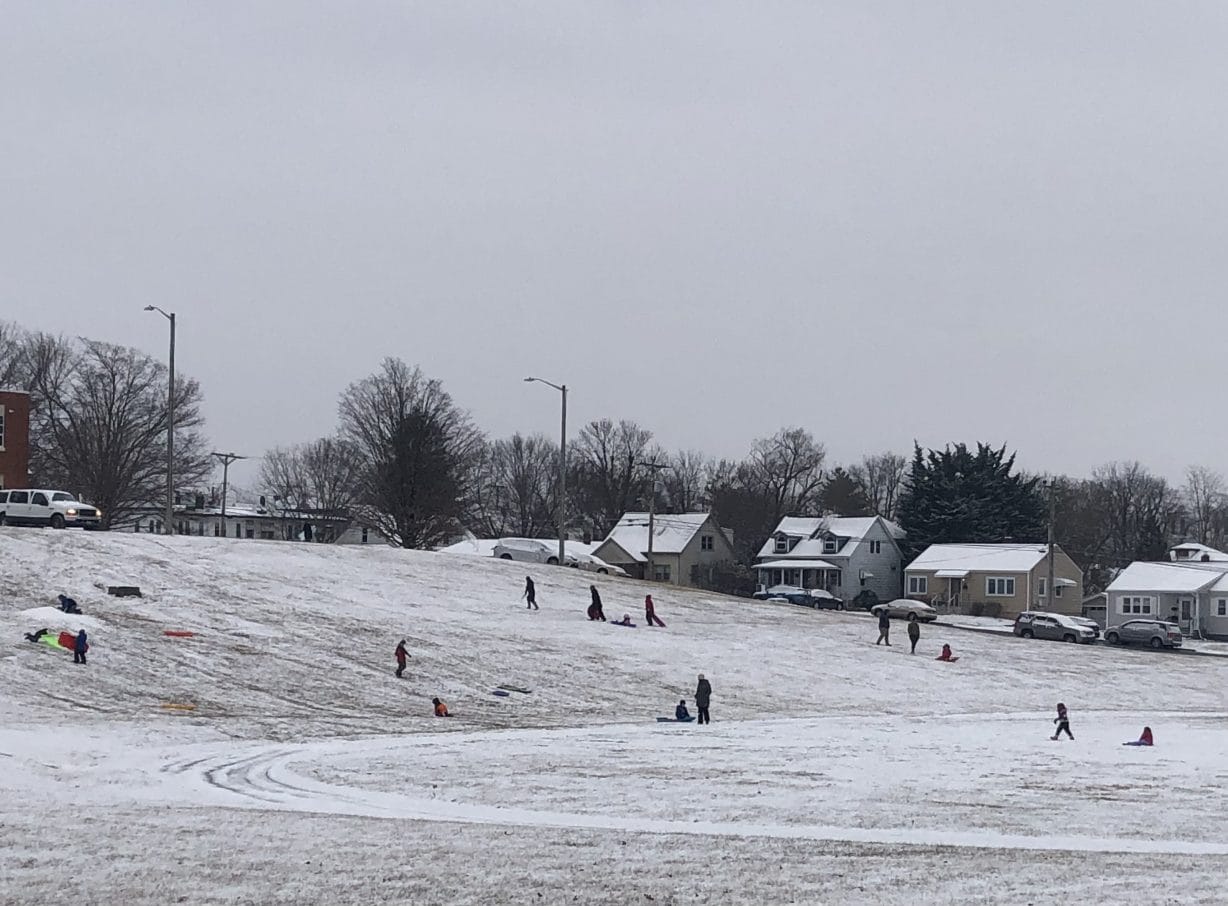
By Sofia Samatar
“The Friendly City” is a weekly column about walking in Harrisonburg that will run during 2024. Each week, your friendly correspondent, writer and teacher Sofia Samatar, will reflect on a walk in our city.
For the past few years, winter in the Friendly City has been mild, the holiday season almost balmy. How enchanting, then, to wake and find the street transformed into one of those blue globes enclosing a snowy scene!
Deep blue clouds thicken the sky, reflected in the blue pallor of the snow. The very air seems blue. The parked cars are draped in winter shawls, blue as skimmed milk. There isn’t enough snow to cover the street, which carves a dark line between the silvery ranks of the porches. But in the Friendly City, we’re not greedy—nor are we prepared to deal with severe weather events. Extravagance doesn’t suit us. We like unpretentious shops, serviceable vehicles, sensible shoes, and nice, considerate snowfalls that know their place.
At ten o’clock, a fine snow is still falling. Paw prints dot the whiteness covering my porch steps. When I open the door, the neighbor’s cat runs up to meet me, crying to get into my house, where I know from experience she will make herself right at home. From her prints in the snow, I can see she’s been going from door to door, this bold striped animal, a most civic-minded member of our community, always confident of a welcome and ready to repay generous neighbors by purring and rubbing her bulk against their calves. In this cat’s opinion, all doors should stand open and all who seek lodging should find it. I wish I could practice her radical ideal. But I don’t want to leave her alone in my house, so I click my tongue at her, half scolding, half apologizing, until she pads off to the next door.
The snow is not deep—perhaps an inch has fallen. The blue note has faded from the air, leaving behind a charcoal sketch: a dark gray street, a pale gray sky, and snow trampled into grayish slush or lying thin on the lawns, grass poking through like pencil strokes. Overhead, a hawk moves lazily, launched on the air, gliding across a dense cloud cover that seems stretched just above the treetops, a sky pegged down like stiff, resistant fabric. It’s a tweed sky, an upholstered sky, what I think of as a Dutch sky, after the paintings of the Old Masters: heavy, almost dirty-looking, tinged with yellow, giving the town a closed-in feeling, shutting out the wind.
On a day of snow, the outdoors immediately suggests the indoors. Falling snow means canceled school, postponed meetings, and a desire for hibernation, especially in the Friendly City, where we take even a small amount of snow very seriously. A great yellow snowplow passes me, rolling down a street where not a single flake has stuck. I’m not sure what it will find to plow, but I admire the industry. This vigilant snowplow flashes an orange light against the windows, advising caution, hot chocolate, and, if possible, pajamas all day.
But, as I suspected, the children are out. Approaching Waterman Elementary School, I see a struggling grownup trudging across the snowy grass, dragging a sled with two little ones aboard, one in a bright lavender coat, the other in turquoise blue. And on the slope behind the school, they’re sledding. They’re marching uphill with their candy-colored sleds, then sliding down. There goes a shrieking elf on a plastic disc. Some of them are really flying! Somehow, they’ve scraped together enough snow to build a ramp. Winter sports are being enjoyed here on a small scale, under the fan shapes of the bare, feathery, reddish trees, the lowering, snow-laden Dutch sky. From a distance, the sledders look like characters out of one of those old paintings, maybe figures from a skating scene by Hendrick Avercamp, their tiny, active forms enlivening the landscape.
Here come two children clinging to a toboggan, howling in unison. A man whooping with a child on his lap. Does the snow create an indoor feeling? If so, it’s not only because it encourages people to stay inside but because it can transform the outside into an intimate space. I think again of those Dutch painters who were famous for their interiors, their domestic scenes, and their small canvases, and how even a picture of a frozen canal, which might be so dreary, takes on a festive air when it’s filled with skating figures.
An outdoor feeling, but thoroughly domesticated. This is not a wild outdoors, not a lonely outdoors. It’s a cozy outdoors.
The slope is turning darker, the snow mixed with grass and mud, but the sledders still whizz down, their ramp a compact knob. Their cries ring out faintly, as if muffled by the sky that hangs over the city like a curtain dampened by kitchen steam.
As I turn aside to continue my walk, I catch sight of a lone child seated on a sled, slowly maneuvering it across the flat expanse of the playground, leaning back to push against the ground, inching the runners forward: a solitary wanderer traversing an icy swamp.












